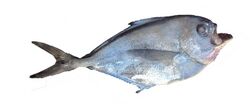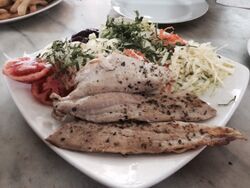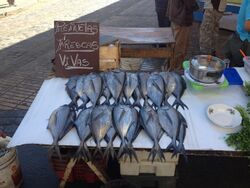Biology:Brama australis
| Brama australis | |
|---|---|

| |
| Scientific classification | |
| Domain: | Eukaryota |
| Kingdom: | Animalia |
| Phylum: | Chordata |
| Class: | Actinopterygii |
| Order: | Perciformes |
| Family: | Bramidae |
| Genus: | Brama |
| Species: | B. australis
|
| Binomial name | |
| Brama australis Valenciennes, 1838
| |
Brama australis also known as Brama chilensis, the southern rays bream also known as reineta (queenfish), is a Perciformes fish species in the family Bramidae. It is endemic to the south of Chile (II and IX Regions)[citation needed].
Biology
B. australis are somewhat laterally compressed. Males may reach 18.5 inches (47 cm) long and females 14.5 inches (37 cm)[citation needed].
Juveniles are found closer to shore while adults are caught largely on the high seas at up to 344 feet (105 m) deep.[citation needed]
Geography
The fish is found exclusively along the Chilean coast especially in the Antofagasta Region (approximately latitude 22° south) through the Los Rios Region (40° south) concentrated along the coast of Lebu (latitude 38° south) in the Bio Bio Region.[citation needed] It is also found in the southern Chilean ocean waters of Tierra del Fuego (latitude 55° south).[citation needed]
Commercial fishing
It is mostly fished by local fisherman along the coast. Since 2001 its industrial fishery has not intensified.[citation needed] There is high demand for it in culinary uses due to its meat and relatively low price, as well as a viable alternative to hake. It began to be fished commercially in Chile in the 1990s [citation needed]
Gastronomy
Its flesh is white and firm. Based on one's preference it may be prepared fried, steamed, baked, or salted. Its particular taste and texture make its meat very appetizing to the local palate.
References
External links
Wikidata ☰ Q2659925 entry




